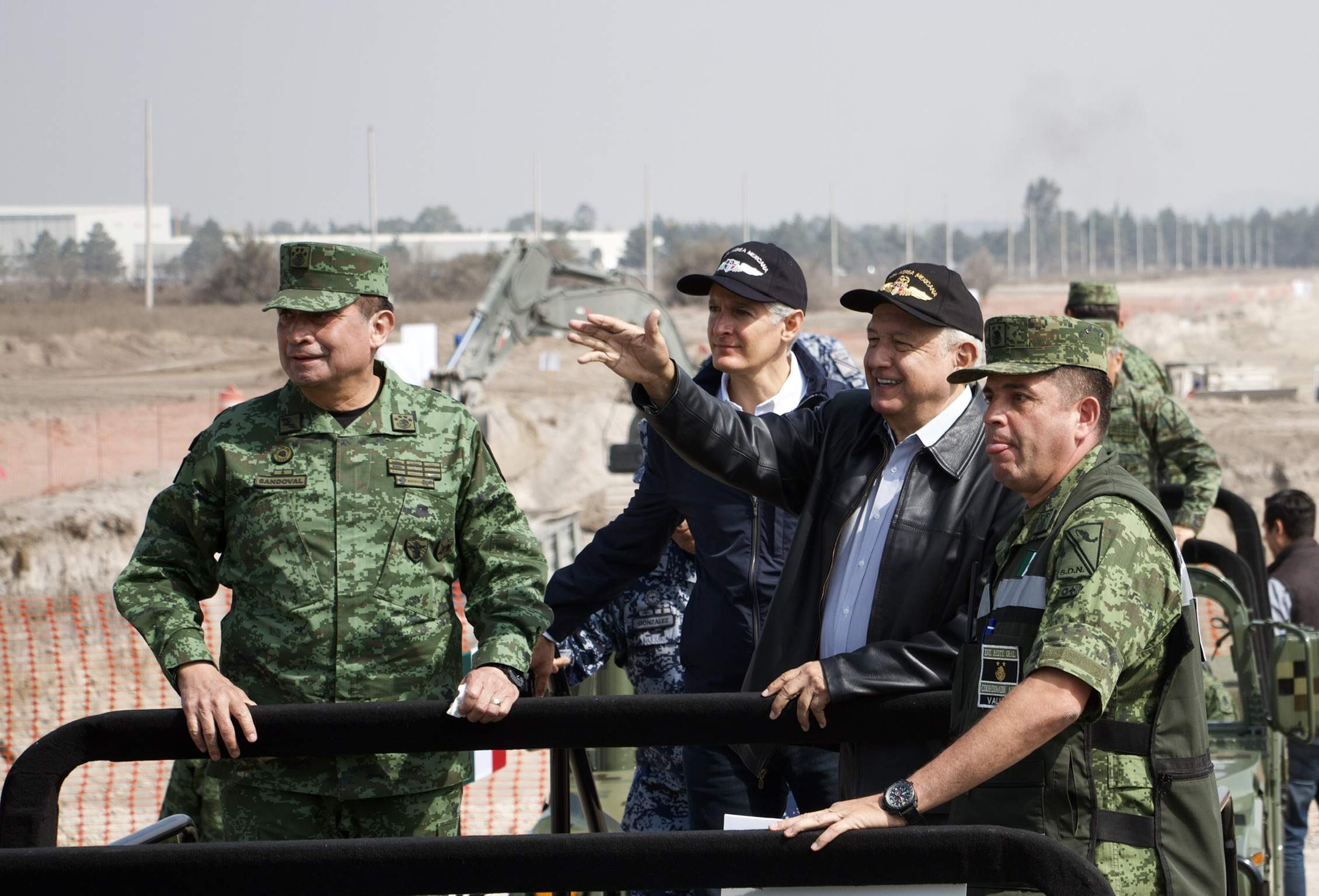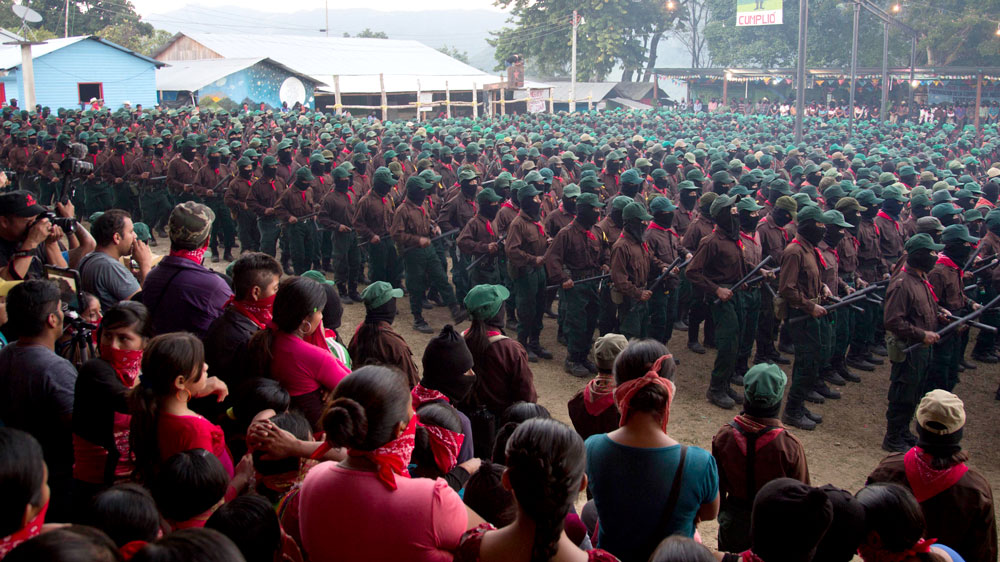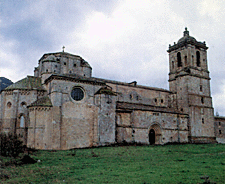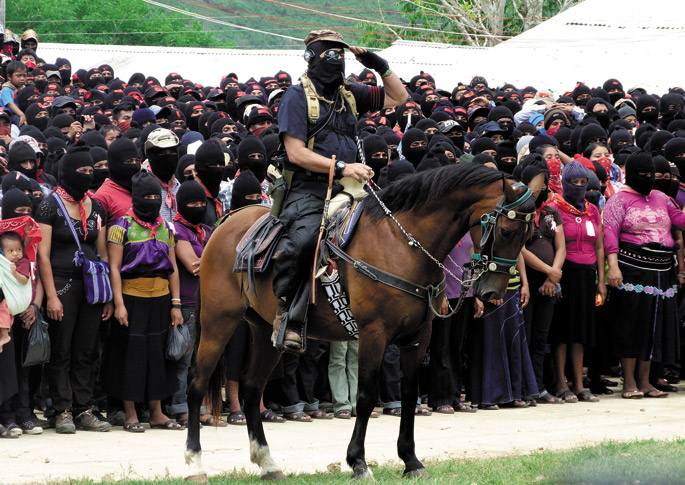30 years of the Zapatista uprising
- On 1 January 1994, hundreds of indigenous people took their faces to tell Mexico and the world: “Enough!” Since then, the EZLN has become a global model for the construction of autonomy, for indigenous peoples to live outside capitalism. However, the current situation is more cruel than ever, as they are at the centre of drug trafficking and paramilitaries.

Getting to San Cristobal de las Casas is simple in itself. “In recent months it’s quieter, but before you go, find out if there’s any roadblock, between Zapatistas and narcos the atmosphere isn’t quiet,” says a neighbor of Palenque. We have made the way down a mountain road, on a joint journey of several vans, and there has been no problem.
San Cristobal is the second capital of Chiapas, and it was there, the first day of January 30 years ago, when the Zapatista uprising that put everybody looking at Mexico. On 1 January 1994, Mexico entered the Free Market Treaty with the United States and Canada, and that is why the EZLN chose the date: about to inaugurate the new era of neoliberalism. The story was coming further back.
Since 1983, in the jungle of Chiapas, the indigenous people were organizing and forming themselves politically. It didn't come out of nowhere, and in short, three rows came together to create a similar movement. The Zapatista National Liberation Army (Zapatista National Liberation Army), formed by members of the armed group National Liberation Force, a politicized group of indigenous people and return movements of Liberation Theology, revolutionized the history of Mexico forever.
Chiapastes Pedro Faro remembers that day. He was celebrating a new year with his family and saw the guerrillas back home: “News spread that the Guatemalan army had invaded Chiapas. We were asked to stay in the houses. We had to leave the house for a moment, and there we were able to see the Zapatistas. The truth is, they were calm. There was a great contrast between those who offered coffee and tamales (a food) and those who showed hatred against indigenous people.”
Faro has explained that in San Cristobal there was a “colonial determinism”, and in most cases”. “Everything that was indigenous was late, dirty... and racist messages spread continuously.” The following days, of course, were not at all quiet, and they were a turning point in modern Mexican history. After twelve days of war, the first talks began. To protect them, “protective belts” were organized by young and militants from all over the country.
Faro believes that the vision of many citizens changed radically. Schools told the story of the Mayan People, but as a missing people. Consciousness was regained and succession proclaimed. In fact, the Zapatistas are indigenous, but they do not form a single group: they are groups that speak Celtic, Tzotzil, Tojolabal and Chol languages. There are nine other languages spoken in Chiapas, and although they are now accepted, they are fighting for survival.
Pedro Faro is the former director of the Centre for Human
Rights Fray Bartolomé de las Casas (Frayba). They follow up the indigenous groups in the resistance, try to record human rights violations in the region. “It is impossible to monitor the violence in Chiapas and Mexico,” he explained, a little frustrated. “The state hides it, but relatives often do not want to denounce it.” How is that possible? He recalled a case that took place a few months ago: “Ten disappeared in a village. We made the report and when we were going to make the complaint public, they told us that if we didn’t, the narco would release two people.” So, between the cases that occur and those that are reported, there is a difference that cannot be known.
The Quintet of Cancuc
shows us a brutal example of this violence. Juanpi is well known in San Cristobal, especially for the Basques, owner of the bar Paliacate and member of the collective Presxs in struggle: “We have had to change the concept of political prisoners to deal with different cases.” The Mexican state is a “guilt factory”.
In particular, he organised a visit to Cereso 5 prison on Sunday and invited the brigadists at the Junax volunteer centre. It is a day of visit, and there are many family members outside prisons. Black, blue or green clothes cannot enter, so the members of the brigades have been forced to rent their clothes abroad.
It has nothing to do with the jails in Spain and France – we have introduced chickens, cafes and others. Families are in a kind of garden with prisoners, eating and drinking Coca-Cola. We enter the gallery and around the football field are the cells. They are divided into octaves, in painful conditions. They also have to buy a bed. Augustine, for example, has slept on the ground for a year and a half.
We've been with five San Juan Cancuc prisoners. Your case is horrible. On May 28, 2022, a drunk and drunk policeman fell into his neighborhood and was wounded. Three people accompanied the police, who were rescued from the site with wounds of various kinds, but who were uneasy. The following day, they were arrested on charges of drug trafficking. Three days later, they are charged with a murder offence for the death of the agent due to the injuries sustained. They suffered severe torture: needles were stuck in their fingernails and eyes, electrodes, beatings... The following day, the cousin and neighbour who came as witnesses were also arrested and charged with the same facts. They're jets and they barely knew Castilian. They could not defend themselves and signed the indictment of murder.
Augustine had all the details of what happened: “Thank God we know that we are innocent, but it is injustice. Yesterday my daughter came and asked me if I don’t want them because I’m here,” she says in tears.
Eduardo Galeano wrote the same story: “In 1986, a Mexican deputy visited Cerro Hollow prison in Chiapas. There, he met a short Indian, who cut his father's head and was sentenced to 30 years in prison. But the honourable Member discovered that the deceased father was going every noon to bring tortillas and beans to the imprisoned prisoner. The interrogation and judgment of the poor prisoner were in Spanish, which he understood little or nothing, and with the help of a good suit, he confessed that he had been the author of something called parricide.”
At the time of his release from prison, we asked Juanpi why they were charged with the crime, knowing that they were innocent: “Because they are indigenous and poor. Instead of investigating the crimes, the crimes are attributed to the excluded and they are already in place. This prison is full of innocent people. That’s why it’s the factory of guilty states.”
Pedro Faro, from Chiapas, explained that what happens in Mexico “is the largest scale of capitalist violence.” It started in the north, then in the middle, and now it's come to Chiapas. There was “narkoa peace”, through signs and agreements between the state: “In 2006 we discovered a narcos airport in the jungle of Lacandona, and despite the denunciation, the state did nothing. We saw that there was coexistence and decided not to denounce it anymore because we risked.”
Criminal groups already existed, but after the COVID-19 pandemic, violence skyrocketed with evictions, killings, expropriations and displacement: “Things started to change in June 2021. Tuxtla Gutiérrez Chiapas, son of a capo named Tio Gil, was killed in the capital of the province of Chiapas. He collaborated with Chapo Guzmán.”
After this murder, the struggle for control of the territory began. Drugs are not the only goods transported. In addition to cocaine, traffickers also move another “commodity”: people. Before, there were ten steps of migrants from Guatemala to Chiapas, and today they are over 90. And the two biggest posters in Mexico are fighting each other for their control.
When narcos occupy a territory – and are not few in Latin America – they occupy the whole territory. Land, houses, cars -- it can be anything for the narco, and the penalty is too expensive for those who don't pay it. That is why the current situation in Chiapas, and in all of Central America, is a disaster. Beñat vasco [invented name] volunteered at a migrant centre in Tabasco: “People who have fled Guatemala do not escape due to lack of work. He opens a store and he's showing up the narco and he tells him that he has to pay so much money to the cartel. They don’t want to live to pay the state and narco and go to the United States in search of luck.” But the road is not easy. “He who has cut off his hand; he who has shot but has not died; he who has burst the two eyes of a machete blow...” A whole continent fleeing extreme violence is going through Mexico.
One of the biggest obstacles for narco and paramilitaries to understand the situation
in Chiapas is to identify the source of violence. What appears from the outside as a war “between Zapatistas and narcos” is by no means a reflection of reality. Although for many it is an unknown, the Zapatistas, of the 1996 peace agreements, have not caught a single shot. At least that is assured by the members of Frayba.
The map of violence is therefore very complex. Please note that there are at least nine armed groups in the territory. In addition, paramilitaries and narcos. Chiapas is a time bomb. Most armed groups are regional self-defence structures to defend themselves against drug trafficking. However, these may have a different development.
The head of the CHAMBER of Frayba (Civil Observation Brigade) explains the clon-plexity [he chose not to give his name]: “In the town of Panteló, for example, the Herrera cartel was introduced and a self-defense group called Machetes was created. This group suffered a split and now works with the narcos. Before, I was very smart. The Mexican State and the Cia created, trained and financed armed groups in order to fight the insurgency. Now the situation is very different. They defend the interests of Narko and the State, but in most cases they are indigenous, indigenous men.”
In any case, there is no doubt: “The Mexican State is directly responsible, because, even if it does not generate them, it does not try to stop them, and it refuses our complaints.”
The situation has not been new for more than 30 years. The State developed a special plan to curb the EZLN and indigenous struggles: Plan Chiapas 94. The current situation is the continuation of those military plans. One of the most dramatic examples is Acteal.
On 22 December 1997, 45 indigenous canals were killed in a church in the community of Acteal while praying for their prayers. In total, sixteen were boys, girls and adolescents, twenty women and nine middle-aged men. Seven of them were pregnant. About 90 paramilitaries died inside the church in an operation that lasted for seven hours, about 200 meters from a police force.
Despite the fact that several citizens and military personnel have been tried by the National Hearing, it has never been clear what State participation was. Human rights activists have no doubt: Like the assassinations in Mexico City in 1968 and the disappearance of 43 students from Ayotzinapa in 2014: “It was a state.”
The First Declaration of the Lacandon Jungle, read by Subcomandante
Marcos in 1994, imposed a classical Marxist vision: to destroy the army and to seize the power of the State through the vanguard guerrillas. Over time, however, the Zapatistas have been developing other kinds of approaches. After the failure of the San Andres Peace Accords of 1996, they separate themselves from armed confrontation and work in the construction of autonomy within the Lacandona Forest, as stated in the Sixth Declaration of the Lacandona Forest. Since then, the movement has grown and, above all, it has transformed.
Today, knowing how many Zapatistas are is impossible. That is one of the strengths of the Zapatistas. Feminist activist Lupita, who works with Zapatistas, says: “I once asked one of the colleagues and said to me, “A chingo, we are a chingo” (we are many). The last time they appeared to the public was against the war between Ukraine and Russia, in mobilizations that took place in several cities, where nearly 100,000 people gathered. “It was very exciting to see the Zapatistas back in town,” he recalls.
Autonomous Munizipio, Caracol and the Good Government Commissions were created in the early 2000s, and thus the Zapatistas developed an effective revolution without state structure. However, civil structures have been dismantled since last year to protect them from the state of violence in the country and, at the same time, to take another step in the revolution.
In the midst of the storm,
the Zapatistas call the current situation 'Storm' 'non-property'. In the midst of the capitalist and climate crisis, attempts are being made to build a new world. “The Zapatistas build theory through practice,” says Pedro Faro. In recent communiqués, the EU Non-Ownership and Implementation Unit have been claimed.
“Lack of ownership and communion are very interesting approaches, because they threaten capitalism. It’s a revolutionary action, the Zapatistas are always changing and turning.”
Although they have now explained this, they have been doing so for several years. The Zapatistas have “recovered lands”, which are owned by the organization. They do not have ownership papers and it is for them to cultivate their fruit. “That creates a toilet, that property belongs to no one.”
In Faro’s opinion, we have to wait to assess its consequences, but he believes that “as a symbolic act, it has a great value”: “We have it within capitalism, we put the sense of ownership to the whole world. What about expropriation? It serves to contribute to these kinds of experiences. For the Zapatistas, that is: How do we break the capitalist system? How to break the wall? Does the rise on the right that we are seeing in the world have no other alternative?”
The State of Narkoa As has already been mentioned, the situation is now extreme in Chiapas. “Before, if the Mexican state attacked the Zapatista, we had the pressure of the international community. What can we do about Narkoa?” Lupita asked.
The problem with narco is the artifact: “They are very young boys, they have no future. It is estimated that the average duration is 2-3 years, and the deaths are less than 20 years old,” explains Lupita. But the problem doesn't have an easy solution. “They have an infinite army of poor people.”
Felipe Calderón's government, for its part, described narcotics as "war". But things have only worsened. And even though today there's "the most progressive government of all time," things don't go much better.
We have to step back a bit to learn about the history of Mexican democracy. The Institutional Revolutionary Party (PRI) has ruled the country for almost 60 years. For Pedro Faro they have been “a dictatorship, no doubt”, the governments of the PRI. “Violence has been systematic and PRI has left more deaths, torture and disappearances than in other dictatorships.”
The National Reconstitution Movement (Morena) turned the situation around and, for the first time, a “real” left-wing party won the elections – by then the PRI was already declining, as since 2000 the right-wing National Action Party (PAN) won the elections. Andrés Manuel López obrador (Amlo) has until recently been the President of the Government, and is currently Claudia Sheibaum, who served as President. It is left by discourse and image, but it is “exactly the same” for the militants of Chiapas: “Or worse in some things. Because Morena has done things that neither the PRI would have done.”
They denounce that a further step is being taken in the neoliberal project: “They are materializing the dream of the PRI, tourism development yes, but not that of wealth,” says Faro. In the area of indigenous people, they promote development projects through grants, etc. “But in exchange for that, they ask the communities for political demobilization. If they collaborate with Zapatistas or other projects, they take away subsidies.”
Morena has made great strides in Mexico. For example, the creation of retirement provision, for the first time in history, and many popular sectors are happy with these changes. Today, however, it has not taken and will not be able to take the necessary steps to stop systematic violence. Many amlovers do not want to see the state of Mexico as one of the most corrupt and violent in the world.
In some models for the world,
the Zapatistas, therefore, advance in the middle of the storm. On the one hand, the state and on the other, organized crime. Both are the extreme forms of neoliberalism that bring to those of always the usual.
Neozapatism offered a model for the world left. In the 1990s, when the economic model of socialist revolutions failed, when the vision against authoritarianisms grew, the Zapatistas were a beacon for those who believed in “another world.” In Mexico, first, and then in Latin America, it was a revolution in favor of indigenous rights.
Every triumph of these is insignificant. There, lost in the forest, he stays in a community. But through the construction of autonomy, the capitalist system is being challenged. The Zapatistas, in fact, do not have the possibility to change the whole world, but through the construction of autonomy they interrupt the whole world.
The Zapatistas are making a stateless revolution. Cultivating dignity and hope in a country in full poverty. It's not a model for everybody, but it shows that yes, in that particular place you can build another world. And, of course, also on other occasions.
Sevillako Atletismo Mundialean agertutako «Repatriation bask prisoners» mundura barreiatu du Presoekin Elkartasun Kideak taldeak. Hogei minutu luzez gainera. Espainia aldean alderdien arteko liskarra sortu bazuen, Euskal Herrian, oro har, irribarra piztu du.
“Ez da gizonen eta sistemaren lana guri askatasuna ematea; kontrara, sistema kapitalista patriarkalaren lana gu menpeko egitea da”, esan zuen emakume batek zapatistek antolatutako emakumeen lehenengo Nazioarteko Topaketaren irekiera ekitaldian, Desinformémonos... [+]
Sistema kapitalista, matxista eta patriarkalaren aurka ari diren emakumeen nazioarteko topaketak deitu dituzte EZLN eta Batzar Klandestino Iraultzaile Indigenak. Martxoaren 8, 9 eta 10ean egingo dituzte Txiapasko Tzotz Choj eremuan, Morelia Karakolan. Harrera martxoaren 7an... [+]
EZLN Askapen Nazionaleko Armada Zapatistak antolaturiko V. Indigenen Kongresu Nazionalean 2018ko estatuko hauteskundeetan parte hartzeko asmoa azaldu dute. Hautagai independente bat aurkeztuko dute horretarako, emakumezkoa.
Txiapasen Aldeko Taldeak, Esko Zap %100 amets haziak lelopean, egitarau zabala prestatu du aste zapatistarako.
Sylvia Marcos-ek “Más allá del feminismo. Caminos por andar” liburua aurkeztu du Mexikon. 20 urte bete dituen mugimendu zapatistan emakumeek eginiko lorpenez eta feminismoa deskolonizatu beharraz dihardu.
“EZLN ez da mintzatuko gehiago nire ahotik” esanaz amaitu zuen hitzaldia Marcos azpikomandanteak maiatzaren 24an mila indio zapatista eta beste hainbeste kanpotarren aurrean. Bere izarra itzali aurretik, Marcosek azaldu zituen Mexikoko Chiapasen burutzen den... [+]




















